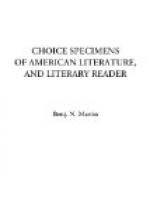... The war being over, the Indians who had been engaged in it freely confessed to their friends and relations, and to some white people they had heretofore been acquainted with, that “the Brethren’s settlements had been as a stumbling-block to them; that had it not been for these, they would most assuredly have laid waste the whole country from the mountains to Philadelphia; and that many plans had been formed for destroying these settlements.”
[Footnote 33: Prominent among the Moravian clergy for his experience of missionary life among the American Indians, for his knowledge of the Indian languages, and for his lifelong devotion to the missionary work.]
* * * * *
=_Jeremy Belknap, 1744-1798._= (Manual, p. 490.)
From “The History of New Hampshire.”
=_113._= THE MAST PINE.
Another thing worthy of observation is the aged and majestic appearance of the trees, of which the most noble is the mast pine. This tree often grows to the height of one hundred and fifty, and sometimes two hundred feet. It is straight as an arrow, and has no branches but very near the top. It is from twenty to forty inches in diameter at its base, and appears like a stately pillar, adorned with a verdant capital, in form of a cone. Interspersed among these are the common forest trees of various kinds.
When a mast tree is to be felled, much preparation is necessary. So tall a stick, without any limbs nearer the ground than eighty or a hundred feet, is in great danger of breaking in the fall. To prevent this the workmen have a contrivance which they call bedding the tree, which is thus executed. They know in what direction the tree will fall; and they cut down a number of smaller trees which grow in that direction; or if there be none, they draw others to the spot, and place them so that the falling tree may lodge on their branches; which breaking or yielding under its pressure, render its fall easy and safe. A time of deep snow is the most favorable season, as the rocks are then covered, and a natural bed is formed to receive the tree. When fallen, it is examined, and if to appearance it be sound, it is cut in the proportion of three feet in length to every inch of its diameter, for a mast; but if intended for a bow-sprit or a yard, it is cut shorter. If it be not sound throughout, or if it break in falling, it is cut into logs for the saw-mill.
When a mast is to be drawn on the snow, one end is placed on a sled, shorter, but higher than the common sort, and rests on a strong block, which is laid across the middle of the sled.




